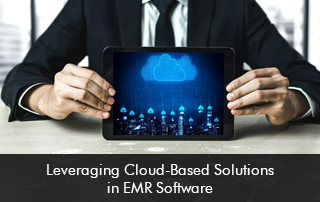In recent years, the healthcare industry has undergone a profound digital transformation, with Electronic Medical Records (EMR) and Electronic Health Records (EHR) software emerging as pivotal elements in streamlining clinical workflows and elevating the quality of patient care. This shift has been driven by the growing demand for more efficient, accurate, and integrated healthcare delivery systems. As part of this evolution, healthcare organizations are increasingly adopting cloud-based solutions for their EMR systems, recognizing the significant benefits these platforms offer in terms of enhanced accessibility, scalability, and operational efficiency
The Rise of Cloud-Based Solutions:
- Cloud-based EMR systems enable seamless data sharing across various healthcare settings.
- They allow healthcare providers to access patient information in real-time, regardless of location.
- This real-time access improves the timeliness and coordination of care.
- The scalability of cloud solutions allows healthcare organizations to expand their infrastructure as patient population needs change.
- Cloud-based EHR systems maintain robust security and compliance with regulatory standards during expansion.
Compared to traditional on-premises systems, cloud-based solutions provide numerous key advantages, including:
Accessibility:
- Cloud-based EMR software allows healthcare practitioners to access patient records and clinical data from any internet-connected device.
- This capability facilitates seamless collaboration and care coordination across multiple care settings and locations.
- The accessibility provided by cloud-based EMR software enhances the efficiency of healthcare delivery.
- Rapid access to crucial information through these systems leads to improved patient outcomes.
Scalability:
- Cloud computing offers exceptional scalability for healthcare organizations.
- It allows EHR systems to be scaled up or down based on changing needs and demands.
- This scalability is beneficial for expanding to accommodate a growing patient population or scaling down during periods of low demand.
- Cloud-based solutions provide flexibility and cost-effectiveness.
- They eliminate the need for significant infrastructure investment.
Data Security and Compliance:
- Cloud-based EMR software companies invest heavily in robust security mechanisms and compliance certifications.
- These measures ensure the confidentiality, integrity, and availability of patient health information.
- Cloud-based solutions help healthcare organizations mitigate security threats.
- They support maintaining regulatory compliance, such as HIPAA.
- Enhanced encryption, access restrictions, and audit trails are employed to strengthen security.
Maximizing the Benefits:
To optimize the benefits of cloud-based EMR software, healthcare organizations should consider the following best practices:
Data transfer and Integration:
- Proper planning and execution of data transfer and integration are crucial for a successful transition to cloud-based EHR systems.
- Healthcare organizations should collaborate closely with their software suppliers and IT teams.
- A comprehensive migration strategy should be developed to ensure a smooth transition.
- The strategy must address any compatibility concerns with existing systems and operations.
Comprehensive user training
Continuous support is required to guarantee the effective deployment of cloud-based EMR software. To foster ongoing growth, healthcare organizations should fund training initiatives that inform staff members about the features and capabilities of the new system and encourage user participation and input.
Enhanced Collaboration and Communication:
- Cloud-based EHR software enables seamless collaboration and communication among healthcare practitioners, patients, and other stakeholders in the care process.
- These solutions include encrypted communications, telemedicine capabilities, and real-time access to patient data.
- Healthcare teams can interact efficiently, exchange information, and make informed clinical decisions, regardless of geographic location or timeline.
- Increased collaboration through cloud-based EMR software promotes multidisciplinary care coordination.
- It reduces duplication of effort and enhances the overall quality and efficiency of healthcare delivery.
Cost-effectiveness and Resource Optimization:
- Cloud-based EMR software is a more cost-effective alternative to traditional on-premises systems.
- It eliminates the need for upfront capital investments in hardware, infrastructure, and maintenance.
- Cloud-based solutions offer a subscription-based pricing model that aligns costs with actual usage.
- Healthcare organizations can scale resources up or down based on demand, avoiding over-provisioning.
- The pay-as-you-go approach maximizes resource utilization and lowers the total cost of ownership.
- This model allows healthcare providers to manage financial resources more efficiently.
- Funds saved can be redirected toward strategic investments in patient care and innovation.
As technology advances, the future of EMR software rests on embracing cloud-based solutions to foster innovation and improve patient care. With ongoing advances in cloud computing, artificial intelligence, and data analytics, healthcare organizations can leverage the power of cloud-based EHR software to transform healthcare delivery, improve clinical outcomes, and ultimately improve patients’ health and well-being around the world.








